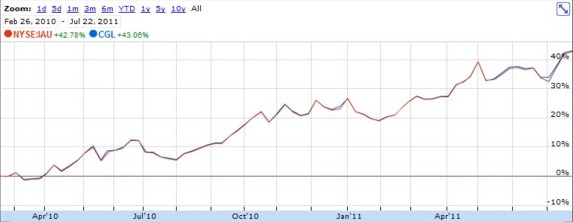

In Monday’s post, I answered a reader’s question about the iShares Gold Trust, an ETF that is cross-listed on the Toronto and New York Stock Exchanges with the ticker symbols IGT and IAU, respectively. I explained that while it is possible to buy and sell this product in either US or Canadian dollars, neither version gives you any exposure to currency risk. However, that’s not the case with the Claymore Gold Bullion ETF (CGL), which also tracks the price of the yellow metal by holding gold bullion. CGL is unique among gold ETFs in that it uses currency hedging.
It’s worth pausing to think about this concept. As most index investors know, it’s common for funds that hold foreign stocks or bonds to hedge their currency exposure to protect Canadians from the effects of a rising loonie. But gold is not a foreign-denominated asset, like shares in Coca-Cola. Yes, its price is widely quoted in US dollars, but that’s not the same thing. Think about it this way: if you were buying gold bullion from the Royal Canadian Mint, would it have occurred to you to hedge your purchase against a falling US dollar?
An extra layer of risk
So what’s going on with CGL? Claymore has designed its ETF to deliver to Canadian investors the returns of gold in US dollars. In practice, CGL’s returns should be the same for Canadians as the returns of the iShares Gold Trust (IAU) are for Americans. Since it launched in February 2010, it has done a very good job in this respect:

What investors need to understand is that CGL not only gives them exposure to gold, but also to the US dollar. If the greenback loses value versus the loonie, then a Canadian holding CGL would get a boost in returns. Indeed, since its debut early last year, CGL has dramatically outperformed the TSX-listed version of the iShares Gold Trust: it has increased over 43%, versus 30% for IGT. However, a surging US dollar will detract from the returns of the Claymore ETF, regardless of the price of gold.
While hedging is usually designed to reduce currency risk, CGL actually adds a layer of risk that wouldn’t otherwise exist. Buying IGT or IAU (or coins or bullion) makes you long gold. Buying CGL makes you long gold and short the US dollar.
If this discussion sounds familiar, it’s because the same strategy is used in the Claymore Broad Emerging Markets ETF (CWO), which I wrote about in a previous post. CWO invests in stocks that are denominated in a basket of overseas currencies, but adds hedging against the US dollar.
Doubling down
Using currency hedging in a gold ETF is an interesting strategy, because historically the US dollar and gold have been negatively correlated: when one goes down, the other tends to go up. So for a Canadian holding CGL, a declining US dollar could be doubly good: it would likely correspond with a rise in the price of gold, and the hedging would mean even higher returns in Canadian-dollar terms. If the US dollar were to surge, then CGL might suffer losses on both the gold and the currency.
One would think this relationship would make the price of gold in Canadian dollars more volatile. However, the Fact Card for CGL quotes data from 1994 that shows the standard deviation of gold returns is actually slightly lower in Canadian dollars (14.69%) than in US dollars (15.15%). Whether that would hold up over longer periods, I don’t know.
What I do know is that investors who decide to buy a gold ETF need to understand the role it plays in their portfolio. I think it’s fair to say that most retail investors who own CGL do not understand the currency exposure they are getting. They are likely unaware that they are not just buying gold, but also making an active bet that the US dollar will fall. Hating the US dollar is a popular pastime these days, but it’s a hard decision to justify in a long-term portfolio.
For investors who prefer to get pure exposure to gold and leave the currency plays to the speculators, Claymore launched an unhedged version of its gold ETF (CGL.C) in March. It should be expected to perform in line with IGT, although at 0.50% its management fee is double what iShares charges.
Disclosure: I do not CGL, IGT or any other gold ETF in my own portfolio.












